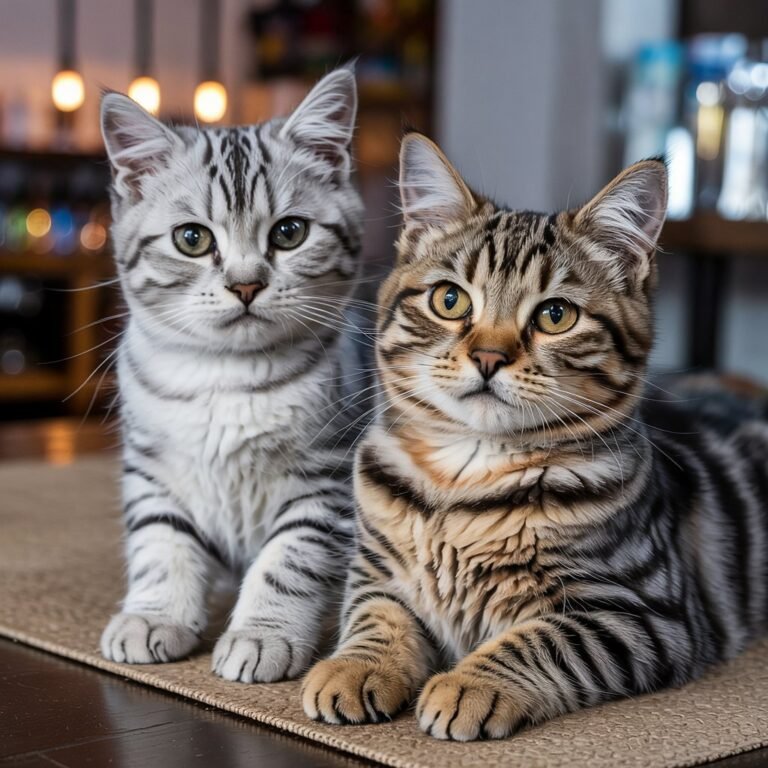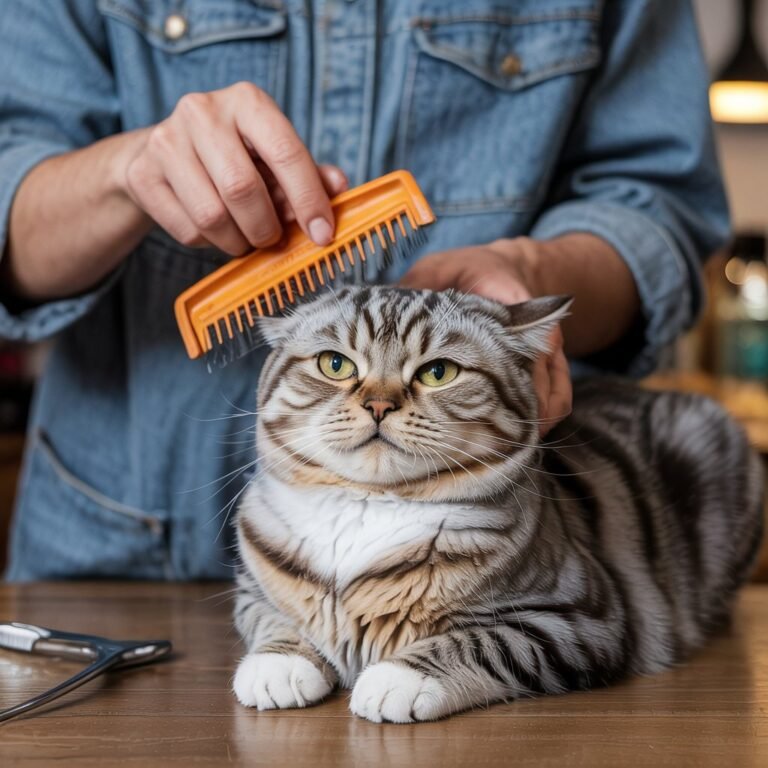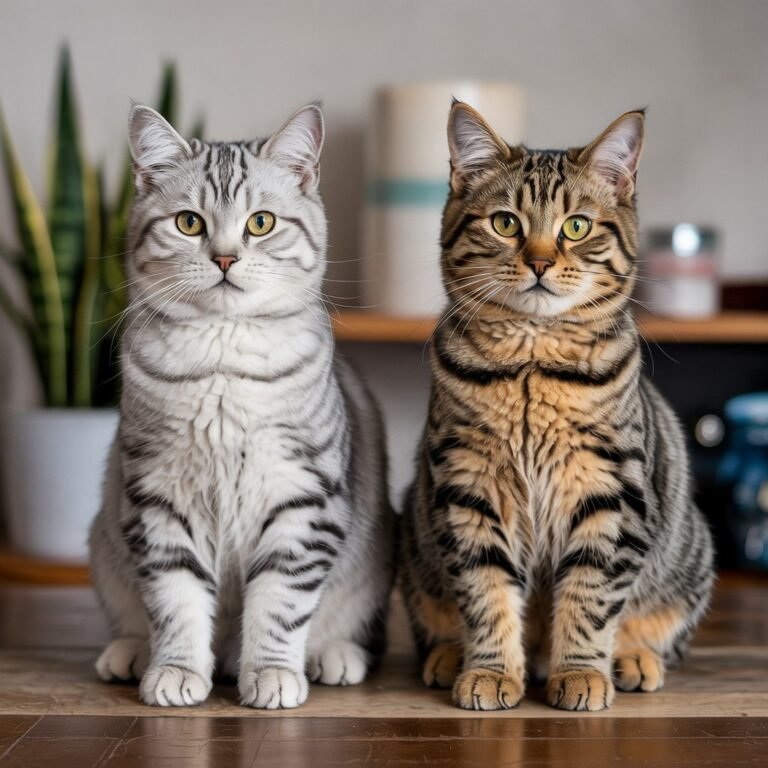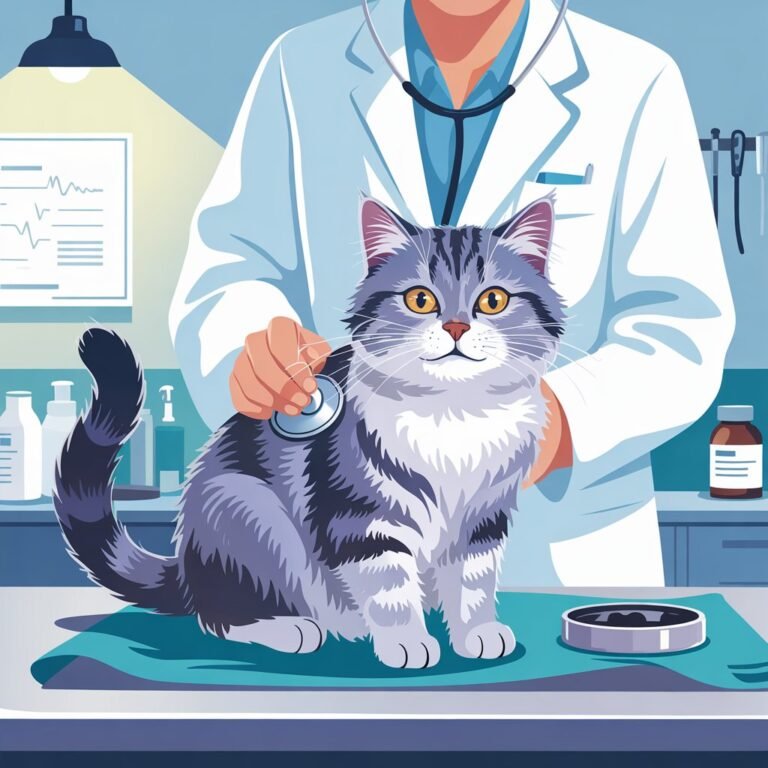American Shorthair vs Tabby: The Ultimate Battle!
When it comes to choosing between American Shorthairs and Tabbies, there’s more than just looks to consider.
American Shorthair vs Tabby: The Ultimate Battle! Both types of cats have earned their spot as a popular choice for pet parents, but their personalities and physical traits can be surprisingly different.
For instance, American Shorthairs are known for their muscular build, which is a result of their hardworking, hunting nature.
Their coats are smooth, and while their markings can vary across the spectrum, you’ll often find whorls, stripes, or even spots.
The famous “M”-shaped mark on their foreheads is a distinctive feature of these cats, making them easy to identify.
I remember when I first spotted a classic American Shorthair in a shelter—its sweet expressions and confident stance made it an instant favorite!
On the other hand, Tabby cats, which is more of a coat pattern than a specific breed, come in a range of colours like gray, brown, and even orange.
They often sport those same M-shaped marks, but their personalities differ slightly.
Tabbies tend to have a more easygoing temperament, especially around children.
That being said, while both breeds share a fondness for hunting mice, American Shorthairs can be a bit more muscular and powerful in their pursuit.
Tabbies, with their various markings, from bands to stripes, can also show a huge variation in looks—each one more charming than the next!
When you weigh the two, it boils down to what you want in a cat—do you prefer the gentle temperament and strength of the American Shorthair, or the affectionate, playful nature of a Tabby?

Table of Contents
ToggleCharacteristics of American Shorthair and Tabby
American Shorthair
The American Shorthair is often regarded as a working cat, known for its impressive agility and stamina.
With a stocky build and muscular physique, this breed is equipped for a life full of action, whether it’s climbing, jumping, or simply chasing after a toy.
I remember, just last month, my friend adopted one, and I couldn’t get over how strong and energetic their new pet was, despite looking so compact and cuddly!
The legs of the American Shorthair provide great support, offering exceptional endurance when on the move.
This breed may look sturdy, but don’t let that fool you; their flexibility and quick reflexes are an unexpected delight.
These cats also feature a large head and full face, with medium-sized ears that enhance their expressive nature. And those large eyes?
They seem to absorb every bit of the action happening around them.
What’s really fascinating about the American Shorthair is the variety of colors and patterns it comes in.
From a sleek silver tabby to other equally stunning coat designs, this breed is as diverse as it is beloved.
Whether you’re looking for a common, popular pet or just want a breed that stands out, this cat fits the bill.
One thing to note, though, is that despite their low-maintenance reputation, they do shed.
Regular combing is key to keeping your cat’s coat shiny and healthy, as it helps remove dead hair and manage skin oils.
I’ve found that consistent brushing can help prevent dry skin or itchy skin issues.
After all, no one wants a cat with a dull, uncomfortable coat!
Tabby
The tabby cat is arguably one of the most ubiquitous and beloved types of domestic cats.
Thanks to a specific gene responsible for the iconic tabby pattern, it’s found across many breeds.
Whether it’s a coal-black cat basking in the sun or one with hidden markings revealed as they stretch out, the variety in tabby patterns is impressive.
I’ve seen everything from subtle stripes to wildly patterned pets that seem to show off their coat as a badge of honor.
Interestingly, tabby cats are not a breed in themselves, but rather a coat pattern found in numerous breeds, which is why you’ll find them everywhere—from your local shelter to high-end breeders.
A quick look at any breed, like the Maine Coon (one of the largest cat breeds) or even the Singapura (the smallest cat breed), and you might be surprised to find a tabby pattern hiding beneath their fur.
It’s not just about their good looks either; tabby cats often possess incredibly engaging personalities.
They’re typically friendly, curious, and outgoing, making them excellent companions for anyone willing to show them a bit of attention.
In fact, from my own experiences, these cats always seem eager to meet new people—no shy cats here!
Tabby enthusiasts swear by the charm of these creatures, often highlighting their impressive socialization skills with both humans and other pets.
The best part? Their size doesn’t matter much when it comes to their temperament; it’s all about that heart of gold they carry around!
History of Both
American Shorthair
The story of the American Shorthair begins in 1620 when the Mayflower brought the first settlers to North America.
These early cats, descendants of European forebears, played a vital role in protecting the settlers’ homes by hunting rodents and squirrels.
By the time the ship docked in Jamestown in 1634, they had proven themselves as excellent hunters, with their muscular bodies and dense coat making them well-suited for the tough conditions of the New World, including the cold winters.
I was fascinated to learn that these cats didn’t just survive; they thrived, helping keep settlements free of rat-laden and mice-laden environments.
These domesticated shorthairs were not only working cats but also loyal companions, a relationship that would only deepen over the centuries.
By 1895, the U.S. cat show began to recognize these hard-working cats, and by 1906, the Cat Fanciers Association (CFA) had started formal breeding programs.
The unique characteristics of the American Shorthair, such as its moderately large size and prized personality, were becoming increasingly popular.
Although originally randomly bred, selective breeding soon aimed to enhance both its looks and temperament.
By 1966, the American Shorthair was officially recognized as a distinct breed, and it quickly became one of the top 10 most favored cats in North America.
These cats were now being bred not just for their muscular body and robust health, but for their gentle and affectionate nature as well.
They could be found everywhere, from barns to shipping vessels, and even in the homes of those who prized their easy-going demeanor.
The American Shorthair had come a long way from its early days as a working cat to a cherished household companion.
Tabby
Tabby cats are more than just adorable pets.
They have a fascinating history that goes way back.
You’ve probably noticed the unique “M marking” on their foreheads.
It’s one of the things that makes them stand out.
This marking is connected to the Egyptian Mau, one of the first breeds linked to tabbies.
The Mau is said to resemble the African wildcat and was around in ancient Egypt.
It’s believed that these cats roamed near the pyramids, guarding sacred tombs.
Even Cleopatra loved them! How cool is that?
Over time, tabby cats spread all over the world.
They made their way from Egypt to places like the White House.
In fact, Abraham Lincoln had a famous tabby as a pet.
But tabbies aren’t just famous for their looks or their history.
They’ve got personalities that draw people in.
Take Delilah, a tabby who inspired a song by Freddie Mercury.
Or Orangey, the orange tabby who starred with Audrey Hepburn in Breakfast at Tiffany’s. That cat’s role was unforgettable!
The Egyptian Mau, with its elegant look, still has a mysterious air about it.
Its Egyptian roots add to its allure.
I’ve had a few tabby cats myself, and each one has had its own special quirks.
Caring of Both

American Shorthair
When it comes to American Shorthairs, one thing’s for sure: they’re incredibly adaptable.
These cats are known for being easygoing and low-maintenance, making them great companions for both first-time cat owners and experienced pet parents alike.
I remember adopting my first American Shorthair—at first, I wasn’t sure if I could handle all the care that comes with a cat.
But honestly, they’re surprisingly easy to manage, especially when it comes to grooming.
A quick brush once a week keeps their coat smooth and shiny, unlike some high-maintenance breeds that require constant attention.
However, despite their calm demeanor, American Shorthairs still love to pounce and play, which means they need a bit of exercise.
Keeping them entertained with a toy or a cat tree can really help burn off excess energy, and you’ll see them happily climbing and exploring their territory.
These cats truly become part of the family—they’re often very friendly and will show affection when they feel like it.
While they might not demand constant cuddles, they still enjoy the occasional nap on your lap or curling up beside you in bed.
In fact, American Shorthairs are famous for their mouser instincts, so if you have a home with a little extra space, consider providing them a place to roam and exercise.
It’s all about finding a balance between giving them time and attention while respecting their independent side.
At the end of the day, I can’t recommend this breed enough—they’re low-maintenance but full of personality, making them perfect for humans looking for a loving, playful companion.
Tabby
When it comes to tabby cats, their distinct coat patterns and personalities make them one of the most beloved breeds.
Whether you have a Maine coon tabby or a more playful Manx tabby, it’s important to understand their specific care needs to keep them happy and healthy.
I recently spent some time with a Persian tabby, and I realized just how much attention these cats need when it comes to grooming.
Their coats, which can range from short to long, require regular brushing—especially in long-haired breeds.
The key is finding the right routine that matches your tabby’s hair length.
Regular brushing helps prevent mats, reduces shedding, and keeps hairballs at bay.
This matters a ton, as hairball medication may only do so much without consistent grooming.
But grooming is only part of the equation.
I’ve also learned that exercise is crucial for these cats.
They need room to play, climb, and explore their environment.
A Manx tabby, for example, loves to leap around, despite its taillessness, so keeping them physically active is a must.
On the other hand, cats like the ocicat require a bit more training to stay engaged and active.
In my experience, even with my own cat, training them to use a scratching post or get involved in interactive play can help keep them in shape and prevent them from becoming bored.
Of course, regular visits to the vet ensure that everything from vaccinations to diet is in check, ensuring your feline friend lives a long, fulfilling life.
Appearance of Both

American Shorthair
If you’re looking for a cat that combines beauty, strength, and a laid-back personality, the American shorthair might just be the perfect fit!
I recently met a stunning male cat, weighing around 15 pounds at 4 years old, and his round head and large eyes left a lasting impression.
This breed is known for its muscular body, giving them a strong, sturdy appearance.
Though their short fur is relatively low-maintenance, don’t be fooled into thinking they’re completely low-shed—these cats are moderate shedders, so a quick grooming session can help keep loose fur under control.
Interestingly, they come in a variety of colors, from the famous silver tabbies to gold and even green-eyed beauties.
Whether you’re admiring a female or male, their appearance is always captivating.
The Cat Fanciers’ Association has long recognized the breed’s striking features and even their distinctive tabby patterns, which can vary widely across individuals.
I’ve seen everything from sleek, hypoallergenic breeds to those with a bit thicker fur. 75% of them boast a consistent appearance: widespread ears, green or gold eye colors, and a short but strong frame.
These cats are known for their calm demeanor and are usually the center of attention in any room.
At just 3 years old, their playful side might still be visible, but they usually grow into incredibly balanced companions.
If you’re looking for a cat that doesn’t need constant attention but still loves to be near you, the American shorthair is definitely one to consider!
Tabby
Tabby cats are known for their incredible variety of color patterns and markings.
Whether you have a Mackerel tabby or a more unique spotted tabby, the range of designs can be mesmerizing.
I’ve always been captivated by how the whiskers of these cats stand out against their fur, drawing attention to their expressive faces.
One of the most common patterns is the Mackerel tabby, with its striking, narrow, solid stripes running down the cat’s body.
These stripes are often compared to a fish skeleton—hence the name “mackerel”—and provide an easily recognizable look.
But there’s also the classic tabby, which features broader bands of color, often in a swirling pattern that resembles a marble.
The agouti hairs, which give the coat a shimmering effect, are a common feature in tabby markings, adding to the rich depth of color.
Then there are the other fascinating tabby variants, like the ocicat, which is a hybrid with spots, or the American bobtail, known for its short, unique tail and striking broken stripes that run along its coat.
If you’re a fan of calicos and tortoiseshell cats, you’ll also notice some interesting caliby (a mix of tabby and calico).
This hybrid pattern can include everything from necklaces of stripes around the neck to rings on the tail.
With these cats, you’ll often see different bands of color interspersed with spots or subtle stripes—each cat’s color pattern is one-of-a-kind.
For anyone interested in moggies (mixed-breed cats), you’ll find that even among these, the tabby markings are widespread, giving each cat its own special beauty.
Whether it’s the petite and delicate markings of a young kitten or the more ponderous look of an adult, tabby patterns continue to capture the imagination of cat lovers everywhere!
Diet and Nutrition
American Shorthair
The American Shorthair is a breed known for its muscular stature and long life spans, often living up to 20 years or more.
As these cats grow, their dietary needs change, so it’s essential to provide a complete and balanced diet to keep them in good health throughout their lives.
When they are young, they require a strict nutritional plan, rich in protein and fat for growth.
As they mature, it’s important to include omega-3 fatty acids and fish oil in their meals to support their joints and keep them joint-healthy.
Supplements can be beneficial, but always consult a vet for advice on whether they are needed, especially as the cat ages and becomes more prone to age-related diseases.
When your American Shorthair becomes a senior cat, it’s crucial to adjust their diet to maintain a healthy weight.
Overweight cats are at higher risk for health problems, so feeding guidelines and species-appropriate food should be followed carefully.
Wet food and kibble can be a good mix, offering a variety of textures and moisture to support hydration.
Excessive weight gain can be avoided by paying attention to carbohydrates and ensuring that their food is well-balanced.
Keep in mind that cats are obligate carnivores, so their diet should be rich in animal-based protein.
Regular checkups with a vet will help manage any necessary changes to their diet as they age.
Tabby
When considering the best diet for tabbies, it’s essential to look into their unique dietary requirements.
Tabby cats, being a popular cat breed, often need a balance of wholesome cat food to stay healthy.
You can choose between dried and canned options, both of which can be a great option depending on your cat’s preferences and needs.
I’ve found that many owners, including myself, find it helpful to research the right food for their specific cat breed to ensure it supports their energy levels and overall well-being.
It’s always wise to consult your vet for recommendations on the right amount of food to give your tabby each day.
This helps to monitor their diet closely and prevent any unwanted health issues like obesity.
Keeping track of your cat’s food intake daily is essential to ensure they’re getting the right nutrients without overfeeding, which could lead to complications in the future.
Health issues

American Shorthair
American Shorthairs are generally a robust breed with a laid-back nature, but they do have some health issues that pet owners should be aware of.
Hypertrophic cardiomyopathy, a genetically predisposed heart condition, is common in the breed and can lead to labored breathing, irregular heartbeat, and weakness.
This condition can severely impact their health if not caught early.
Moreover, obesity is another major concern, as it often leads to diabetes, arthritis, and other chronic diseases.
Managing their weight through a high-quality diet and avoiding overfeeding is crucial for their well-being.
American Shorthairs are also prone to mouth and gum disease, such as tooth resorption and periodontal disease.
Regular brushing and dental check-ups can help prevent these issues.
They can experience respiratory issues too, particularly with their flat face.
This can lead to upper respiratory infections, sneezing, and even more severe conditions like ocular problems, conjunctivitis, or cherry eye.
Keeping an eye on their eye health is important to maintain their ability to see clearly.
Additionally, they are susceptible to Feline Lower Urinary Tract Disease (FLUTD), which includes urinary tract infections, urinary stones, cystitis, and even urethral obstruction.
Symptoms of FLUTD include blood in urine, urinating outside the litter box, and straining to urinate in small amounts.
Many American Shorthairs also face issues with diabetes, which is marked by high blood sugar, increased thirst, increased urination, and weight loss.
Regular vet visits and possible insulin treatments are necessary to manage these issues.
Finally, while they are usually indoor cats, they can still be exposed to parasites, viruses, and bacteria if allowed outside.
Even though they are not typically known for being as prone to accidents, their playful and curious nature can lead to injuries.
Pet insurance can help cover unexpected costs in case of emergencies or acute diseases.
These cats are long-lived, with a lifespan of 15–20 years, especially if cared for properly by sourcing an American Shorthair kitten from reputable breeders.
Tabby
When it comes to your tabby cat’s health, it’s important to know that both purebred and mixed-breed cats can face their own set of health problems.
Although tabby cats are generally known for being robust and healthy, they still need regular check-ups.
Some common concerns include things like obesity, dental issues, and joint problems.
It’s essential to give your cat’s health the attention it deserves, even if they seems perfectly fine on the outside.
Each cat is unique, and their needs can vary.
If your tabby is showing signs of discomfort or you just want peace of mind, take them to the vet.
They can provide individualized care to ensure your cat’s health stays on track.
Keep an eye on any changes in behavior or appetite, as these can be early signs of a problem.
Regular visits to the vet will help spot issues before they become serious concerns.

